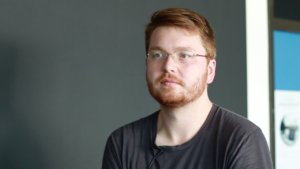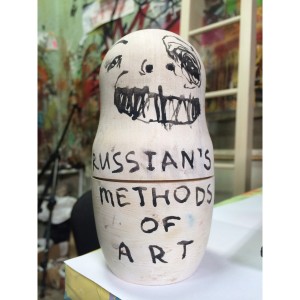There are projects, which are to become a book project, or are intended for an exhibition. A photograph may be a print, or a projection. It is all about testing it. E.g. when I find a picture that I want to use, I don’t know the right size from the beginning. I have to try it. It’s the same with the number of images. I have to try it. It’s the same with decisions about the beginning and end of a story, or when a sequence of images gets boring. Earlier, we talked about the series ‚Regionales Leuchten‘. Those photos neither work as single images nor in groups of five hundred. So, it is somewhere in the middle of one and five hundred. Trying these things and finding sequences are things I like doing. My experience doesn’t help much; I have to try it again and again. The testing, the implementing in a room and the communication with other people, we were talking about earlier, are all part of this process. Once, I left a geography course book with photographs of seascapes from the twenties, untouched for a long period of time. I left it there for many years although these were great pictures that I knew I definitely wanted to use one day. I knew I wouldn’t just use these photographs, but I would have to comment on them in a way or connect them with something else. One day, my attention was drawn to images of battlefields of the First World War. Although the battlefield and the seascape photos had completely different formations, origins and interests, these two sets of photographs came together. Despite their dissimilarity they came together much earlier than I realized. This is why I think that it is important for an art student to read books, novels, not only things that have to do with art in the narrow sense. For example, I know lots of artists whose work is strongly influenced by the music they listen to. To me the interconnections are more important than things that go in the same direction. I once received a bundle of aerial images, 12.000 negatives in total of private homes that were to be sold to the homeowners. With this material I kept myself intensively occupied for two years. I also worked for one year with photos of property damages owned by a Swiss insurance company. Extremely long periods of time, I examined the pictures multiple times… large amounts of images examined several times. I can focus on something and be occupied with it when other people have long given up and know that it leads to nothing. I develop a kind of productive defiance. While doing this I run astray sometimes. Often, I occupy myself with things that actually lead to nothing, but that is OK. I usually leave things to themselves for a longer time. It means that the things I publish or exhibit do not necessarily mirror what I did in the moment or shortly before. To leave something for a while, think about it a lot, and talk about it with others are important strategies for what I am doing. I try to avoid producing something and exhibiting it immediately. Actually I exhibited a group picture two years ago in London, which I had completed and produced ten years earlier. Furthermore, I rarely do only one work at a time. I always do many things simultaneously, switching between one and the other.
Es gibt Projekte, bei denen ich glaube, dass sie schon in ihrer Entstehung eher ein Buchprojekt werden oder Sachen für eine Ausstellung. Was Photographisches kann ein Print bedeuten, es kann aber auch eine Projektion bedeuten. Da ist ganz viel Ausprobieren. Ich kann gar nicht sagen, wenn ich ein Bild gefunden habe und weiß, das will ich verwenden, dann denke ich mir ja nicht eine Größe aus, sondern ich probiere eine Größe aus. Genauso wie mit der Anzahl der Bilder, das sind alles Sachen, die ich ausprobieren muss. Wann in einer Abfolge von Bildern eine Erzählung beginnt und wann sie anfängt zu enden, gar langweilig zu werden. Also wir sprachen vorhin beispielsweise über ‚regionales Leuchten’ über diese Art von Photos, die funktionieren als Einzelbild nicht aber Sie und ich hätten keinen Spaß daran fünfhundert anzugucken, also liegt es irgendwo zwischen eins und fünfhundert. Das auszuprobieren und eine Abfolge dafür zu finden, mache ich einfach gerne. Da hilft mir auch nicht wesentlich die Erfahrung darüber, das viele Jahre gemacht zu haben, sondern ich muss es tatsächlich immer wieder von vorne ausprobieren. Zum Prozess gehört das Ausprobieren und das ganz konkret Machen in einem Raum und dazu gehört das worüber wir vorhin sprachen, der Austausch mit Anderen. Ich hatte ein Buch sehr lange liegen mit Seestücken, Photographien aus den 20er Jahren aus einem geographischen Lehrbuch von Meeresoberflächen. Das hatte ich wirklich viele Jahre da liegen und das sind tolle Photos mit denen ich unbedingt etwas machen wollte. Mir war klar, ich würde nicht nur diese Photos verwenden, sondern ich müsste die in irgendeiner Weise kommentieren oder mit was anderem in Verbindung bringen. Und über eine ganz andere Richtung, wurde ich auf Bilder von Schlachtfeldern aus dem Ersten Weltkrieg aufmerksam. Dann kamen diese beiden Bildgruppen zusammen, die hatten in ihrer Entstehung, ihrer Herkunft und des Interesses jedoch überhaupt nichts miteinander zu tun. Sie haben trotzdem viel eher zueinander gefunden als es mir klar wurde. Deshalb glaube ich ja auch, dass es wichtig für einen Kunststudent, eine Kunststudentin ist, auch mal ein Buch zu lesen, einen Roman, und nicht nur Dinge, die mit Kunst im engeren Sinne zu tun haben. Oder ich kenne eine Menge Künstler, bei denen die Musik, die sie hören, nachweislich einflussreich auf das, was sie machen, ist. Diese Querverbindungen sind wichtiger als das, was in eine Richtung geht. Ich habe mal einen Firmennachlass von Luftbildern bekommen, also 12.000 Negative von einzelnen Häusern, Eigenheimen, die überflogen worden sind, um die Photos an die Hausbesitzer zu verkaufen. Mit diesem Material habe ich mich zwei Jahre intensiv beschäftigt. Des weiteren habe ich mich ein Jahr lang mal mit Schadensphotos einer Schweizer Versicherung beschäftigt. Das sind alles sehr große Zeiträume, ich habe die Bilder immer mehrfach gesichtet, große Mengen Bilder mehrfach gesichtet. Ich kann ganz gut hocken bleiben und mich mit einer Sache beschäftigen von der andere sagen, das führt zu nichts. Da entwickele ich eine Art von produktivem Trotz. Dabei laufe ich aber auch manchmal in die Irre. Oft beschäftige ich mich dabei mit Dingen, die dann tatsächlich zu nichts führen, aber das ist auch o.k. so. Ich habe Dinge immer lange liegen lassen. Das heißt, das was ich veröffentlicht oder ausgestellt habe, entspricht nicht unbedingt dem, was ich in dem Moment oder kurze Zeit vorher gemacht habe. Bei dem was ich mache, ist Liegenlassen, längere Zeit darüber nachdenken und Gespräche führen ziemlich wichtig. Ich versuche zu vermeiden irgendetwas zu produzieren und dann direkt auszustellen. Ich habe tatsächlich eine Bildgruppe vor zwei Jahren in London ausgestellt, die hatte ich zehn Jahre zuvor abgeschlossen und produziert. Das lag wirklich zehn Jahre! Ich mache auch selten nur eine Arbeit, sondern ich habe immer viele Dinge nebenher laufen, wo ich dann von einem zum anderen gehe.

















